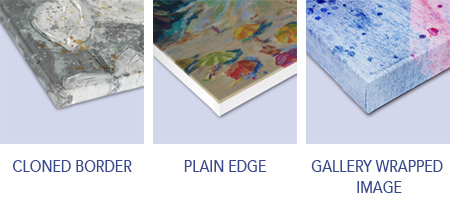Canvas is a popular medium for painters. Once the painting is complete, it is time to decide how best to frame it. While traditional fine art framing is great for some paintings, other paintings on canvas look best with their edges visible in a floater frame or simply gallery-wrapped with no frame at all.
Canvas stretching refers to placing a blank canvas on stretcher bars before the artist begins painting, while a gallery wrap involves wrapping a completed, loose canvas around stretcher bars so that it can be hung. At Rosenbaum Framing, we offer both canvas stretching and gallery wrap services for artists and their completed paintings.
The Different Types of Gallery Wraps
When it comes to a gallery wrap, you have three options: a cloned edge, a plain canvas edge, or a wrapped edge. Some artists strongly prefer one type of gallery wrap over another, and different paintings or framing methods may have different requirements.
A cloned border gallery wrap is when the edges of the image are duplicated, copied, or mirrored from the original image and wrapped around the stretcher bars. With this method, the whole image is still visible from the front, but the cloned edges create a continuous look. Staples are then added to the back of the canvas to hold it tightly onto the stretcher bars. A cloned gallery wrap is a good option when you want the entire image to be visible from the front and don’t want blank canvas to show on the sides of the painting.
Another option is a gallery wrap with blank canvas edges. The completed image is visible from the front and the unpainted canvas edges are wrapped around the stretcher bars. While this type of gallery wrap ensures that the full image is still visible from the front, it is a good choice when framing a canvas with a traditional frame where the sides of the painting won’t show, but may look unfinished when being framed with a floater frame, where the edges are visible, or an unframed gallery wrap where all of the edges show.
The final option is a gallery wrap where the outer edges of the original artwork are wrapped around the stretcher bars. Staples are then added in the back to hold the canvas in place. Because the edges of the gallery wrap are part of the original image, this type of gallery wrap is best for images with less detail or less important image areas on the edges.
At Rosenbaum Framing, we are here to help with all your framing needs. With art framing services in Boca that include everything from initial canvas stretching to final gallery wrapping and framing, we can help you with your canvas painting needs from start to finish. To find out how we may be able to help, contact us today.

